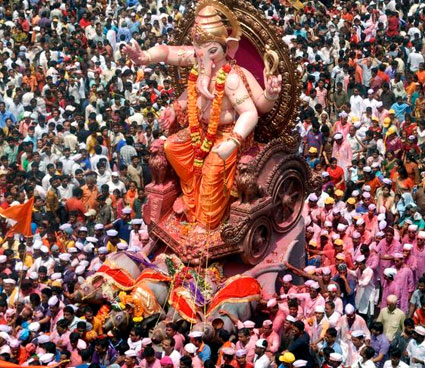TRAVEL INFORMATION INDIA
Ganesh Chaturthi

What is Ganesh Chaturthi? Why is it celebrated?
Ganesh Chaturthi is a ten-day Hindu festival celebrated to honour the elephant-headed God Ganesha's birthday. He is the younger son of Lord Shiva and Goddess Parvati.
Ganesha is known by 108 different names and is the Lord of arts and sciences and the deva of wisdom. He is honoured at the start of rituals and ceremonies as he's considered the God of beginnings. He's widely and dearly referred to as Ganapati or Vinayaka.
There are two different versions about Ganesha's birth. One has it that Goddess Parvati created Ganesha out of dirt off her body while having a bath and set him to guard her door while she finishes her bath. Shiva who has gone out, returned at that time, but as Ganesha didn't know of him, stopped him from entering. An angry Shiva severed the head of Ganesha after a combat between the two. Parvati was enraged and Shiva promised Ganesha will live again. The devas who went in search of a head facing north of a dead person could manage only the head of an elephant. Shiva fixed the elephant's head on the child and brought him back to life.
The other legend has it that Ganesha was created by Shiva and Parvati on request of the Devas, to be a vighnakartaa (obstacle-creator) in the path of rakshasas (demonic beings), and a vighnahartaa (obstacle-averter) to help the Devas
This year, September 17th marks the beginning of this festival which is also called as Vinayaka Chaturthi. Here are some quick facts about the festival: The festival begins on Shukla Chaturthi which is the fourth day of the waxing moon period, and ends on the 14th day of the waxing moon period known as Anant Chaturdashi.
Maharashtra is the state known for grand scale Ganesh Chaturthi celebrations. During the festival, colourful pandals (temporary shrines) are setup and the Lord is worshiped for ten days.



